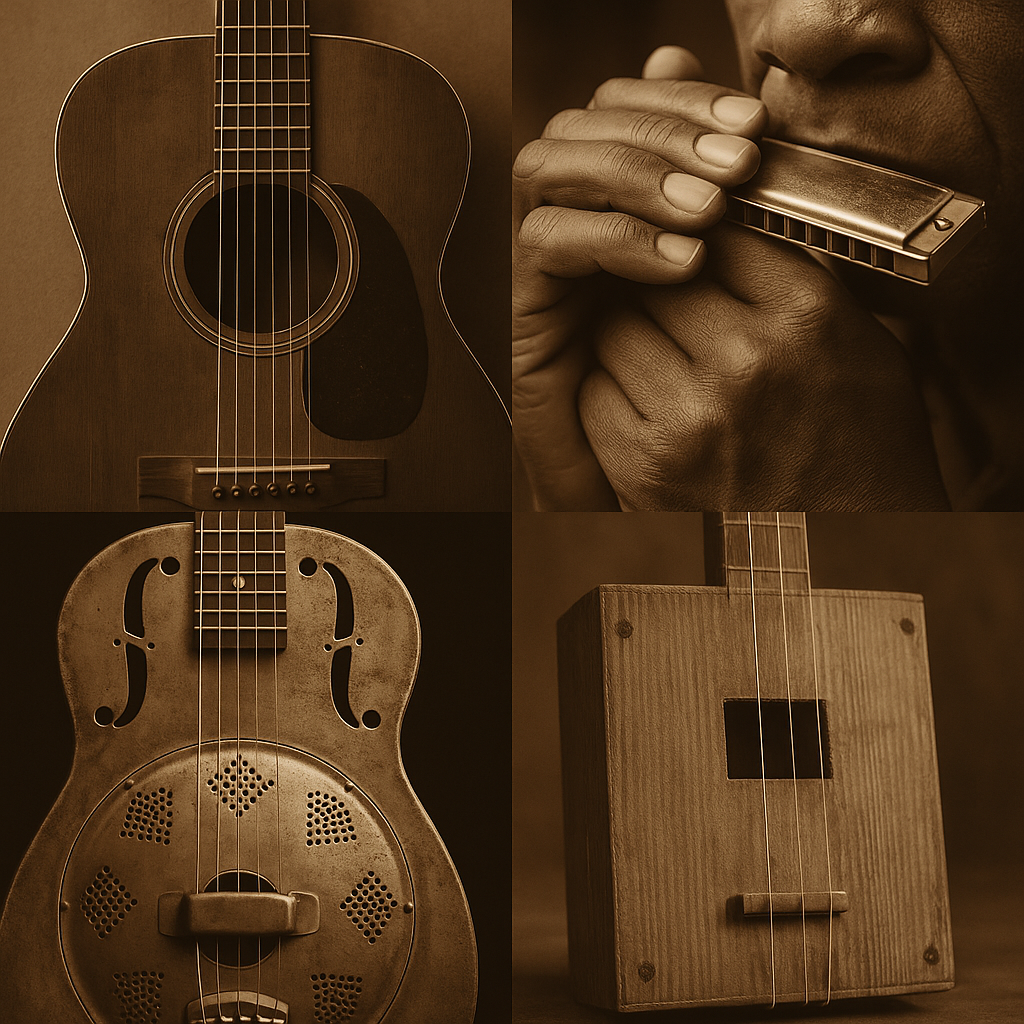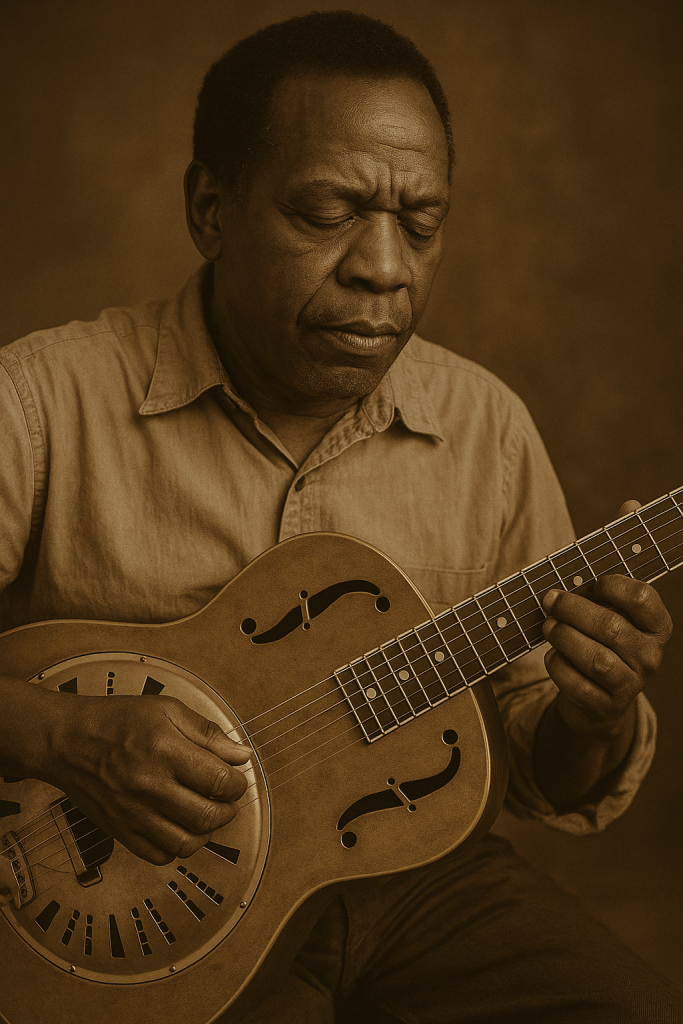Introduction
The instruments of Delta Blues contributed their distinct, layered character to the sound. Each one had an elemental, unfinished quality that was raw, uniquely human, and emotive.
Many were homemade or cheaply made. Its ingenuity thrived in poverty. Necessity demanded resourcefulness.
Basic guitars, harmonicas, and homemade drums defined the powerful sonic identity. They narrated experiences of suffering, hope, and perseverance.
Its sound was earthy and directly emotive. It carried the childlike innocence of old country living and the gravity of surviving.
Easy to play yet expressive, the instruments invited reflection. They gave way to spontaneous, intimate expression at the core of Delta Blues.
Their modesty remains soulful and authentic sounding.
The Acoustic Guitar
The acoustic guitar gave birth to the Delta Blues for one simple reason: there it existed
.
It was cheap, portable, and good for musicians performing on farms, juke joints, or towns.
The guitar didn’t play or tell stories alone.
Delta Blues players fingerpicked bass lines and melodies together, beating time with only two hands.
Slide guitar soon defined the genre’s voice.
Players used glass or metal slides to make the guitar sound like a wailing, human voice.
Sliding created voice-like dynamic shifts between notes.
Robert Johnson was a master of both slide and fingerpicking.
You can read more about Robet Johnson here
His ghostly, emotive style continues to influence guitarists today.
Son House and Charlie Patton pushed these techniques even further.
You can read more about Son House here
You can read more about Charlie Patton here
They pushed the acoustic guitar to do what it wasn’t made for—loud, raw, and emotional.
These weren’t styles based on skill.
They were styles based on emotion when words wouldn’t do.
The guitar became a voice, an outlet for feelings.
It sang the lived experiences of its players with a gritty, authentic voice.
The acoustic guitar wasn’t just an instrument—it helped birth an entire genre.
Its simplicity gave rise to limitless creativity.
That innovation birthed not only Delta Blues but all of blues and rock.
That understanding gives us a greater appreciation for Delta’s cultural and musical legacy.

The Harmonica
The Delta blues sounded raw, emotional, and human with the acoustic harmonica.
It brought richness in both rhythm and melody.
A guttural “wah-wah” quality of begging or crying punctuated the notes.
It captured the heart of the blues, the sadness, happiness, and yearning.
The harp gave the blues a whole new spectrum of emotions.
There was more depth in each note and phrase of music.
Sonny Boy Williamson II played the harmonica like no other.
He was the first to make the blues with the harp and made it sing like a band.
His timing and note placement were incredible.
He gave the melody, beat, and so much more all at once.
He played with more energy and power than most could match.
Even on solo records, he sounded like a full band.
The harp filled in for the horns, drums, and guitars.
The sound of the harmonica made it seem like he had all the band around him.
Overblowing and note-bending sounded like soulful howls.
Every single note and draw felt it deep down in the gut.
It didn’t matter what the ear was feeling.
The singer called out, and the harp called back.
The two exchanged calls and responses in a play-by-play.
The harp cut through beats and filled the space where the singer paused.
It answered the singer, followed, or moved around him with subtle counterpoints.
The harp played call and response with the guitar, too.
And made the band’s roles clear: the harp mattered.
Players used their hands to shape the sound further.
They angled and controlled the breathing to color the sound.
This scratchy, gravelly voice of the harmonica became iconic.
Delta blues has never been the same as we think it is now.

The Resonator Guitar
If you are interested i Resonator guitars, a rare gem in today’s music scene, were once a vital part of the Delta blues music, a genre that has a rich history dating back to the late 19th and early 20th centuries in the Mississippi Delta region.
Resonator guitars, with their unique metal cone body, are a fascinating instrument that stands out in the world of music.
That resonator sits near the soundhole.
It amplifies the sound so it is louder than a typical acoustic guitar.
The metal cone of the resonator guitar is not just a part of its structure, but it’s also the source of its unique, bright, and metallic tone that captivates the listeners.
Most of the resonator’s personality is from the power of its projection.
A regular acoustic guitar uses a wooden body to project sound, but the resonator amplifies extra.
It has more volume and the power to project outside.
That extra volume made it great for outdoor field performances and noisy get-togethers.
Its sound could penetrate the sounds of talk, wind, and even muddy roads.
Early Delta blues musicians needed extra volume.
They had no access to amps or microphones.
Many players would often use a glass or metal slide on these guitars.
The sliding motion on the strings would give the music a wailing vocal sound.
The resonator’s natural tone complimented that slide technique well.
It added a lot of emotion and drama to the blues.
Its volume, tone, and strength made it a favorite among early blues players.
In harsh conditions, it stood out–in both sound and build.
If you are intereted in learning slide guitar I recomend these books
Homemade Instruments
Many early Delta blues players couldn’t afford to buy a guitar.
Instead, they built them out of whatever they could find.
One of the most popular homemade instruments was the cigar box guitar.
Wood, wire, and cigar boxes made up its body.
The majority of these homemade guitars were three or four-stringed, each producing a unique and gritty sound that became synonymous with Delta blues.
That was the blues — raw, accurate, and powerful.
Some were made out of broom handles, tin cans, or rake tines.
They made do with what they had.
Hardship was a constant in the rural black South, yet it was this very adversity that fueled the creativity and resilience of the Delta blues musicians.
But nothing stopped creativity.
Making music out of scrap was the blues spirit — play on.
The do-it-yourself approach started the blues.
Cigar box guitars symbolize Delta blues tradition, grit, and spirit today.
Their rickety, buzzing notes carry the blues banner.
The Human Voice
The human voice, a profoundly emotional instrument, has a unique power. It can sing of heartbreak, helplessness, and the pride of moving on, conveying these deep emotions with an intensity that resonates with the listener.
Like any other instrument, the human voice communicates feelings with a raw, unfiltered directness. It can express pure emotions—anger and desire, immediately and without any barriers, creating a raw and immediate connection with the listener.
A profound connection exists between a person’s emotional state and the sound of their voice. Delta blues, in its gritty and unvarnished expression, embodies this connection.
The vocal style is flat, raspy, and gritty. That harshness mirrors the harsh realities of the Mississippi Delta.
It isn’t polished or pretty—but that’s what makes it so memorable. It communicates truth without needing polish.
The voice in blues is a direct line from emotion to sound. You don’t need words to feel the message.
One groan can speak of heartbreak. A high falsetto can sing of happiness or victory. Every singer has their signature.
Their voice is uniquely recognizable and distinct. You know the singer by both their words and their feelings.
In Delta blues, the voice can be front and center. It can even overpower the lyrics.
In white country blues, the words set the scene. In Delta blues, the voice drives the narrative. Emotion is in charge.
The voice becomes the engine of the music. It powers call-and-response and the raw emotional weight of the performance.
Conclusion
The sound of blues is raw, deep, and from the heart. Using acoustic instruments like the guitar and harmonica keeps things simple and earthy, enhancing the music’s authenticity.
The acoustic guitar provided the beat to tie everything together. Its strumming added some edge and punch.
The harmonica, a versatile instrument, cried from the heart. It lent the music its voice of longing, sadness, and joy, adding emotional depth to the blues.
The resonator guitar gave a loud, sharp note. It cut through the noise with a bold statement.
All of these instruments made blues music authentic and unforgettable. They brought out the truth of hard times and deep feelings.
The influence of early blues artists, who set the standard for popular music, still resonates in today’s blues, rock, and folk, shaping the sound and style of contemporary music.
